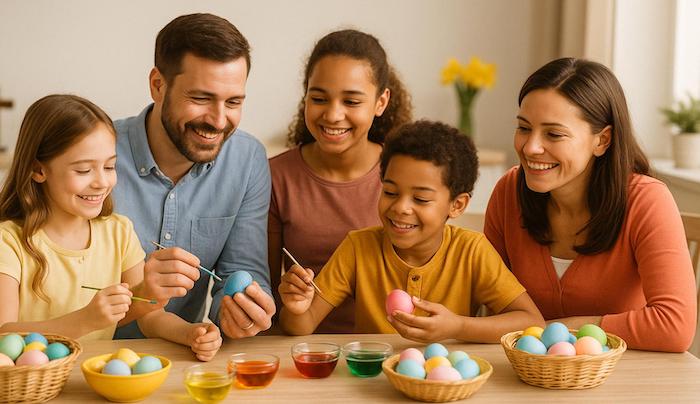Rooted In Ritual: Easter Traditions For Blended Families
Forming Meaningful Bonds Through Easter Traditions

As Easter approached, Will glanced at the calendar with growing apprehension. Last year had felt… off. It wasn’t a holiday disaster, but neither his kids nor his stepkids seemed to enjoy it much. He had tried to carry on the Easter traditions his family always loved—dyeing eggs together, attending a sunrise church service, and hosting a backyard egg hunt followed by a big meal.
But his eight- and ten-year-old weren’t exactly thrilled to include their stepsisters, and his wife’s girls didn’t seem particularly enthusiastic either. What confused Will most was that he wasn’t excluding anyone—he genuinely thought he was making room for everyone.
What Will didn’t realize was that traditions are more than routines—they’re building blocks for family identity and belonging. In blended families, creating new traditions can be a powerful way to connect different pasts into a shared future. While blending families has its challenges, it also offers a unique opportunity to craft something meaningful together. Whether you’re new to the role of stepdad or well into the journey, shared rituals can help create bonds that last.
What Will didn’t realize was that traditions are more than routines—they’re building blocks for family identity and belonging. In blended families, creating new traditions can be a powerful way to connect different pasts into a shared future. While blending families has its challenges, it also offers a unique opportunity to craft something meaningful together. Whether you’re new to the role of stepdad or well into the journey, shared rituals can help create bonds that last.
Understanding the Family Dynamic
Before diving into new traditions, take time to understand your blended family’s dynamic. Every member brings their own memories, preferences, and expectations. Honoring the traditions that already exist—like Grandma’s famous holiday dinner or a summer camping trip with their other parent—shows empathy and maturity. These rituals hold emotional weight, especially for children.
It’s also valuable to explore what your new family enjoys together. Maybe some love hiking while others prefer baking or storytelling. Consider age differences, cultural backgrounds, and what brings each person joy. You don’t need to figure it all out right away. Starting conversations about what matters to each person lays the groundwork for creating natural, meaningful traditions.
As with all areas of stepfathering, communication is key. Ask what traditions they miss. What makes family time feel special to them? Letting each person share helps everyone feel valued—and more willing to help shape something that reflects your blended family.
Introducing New Traditions
While most traditions evolve over time, blended families benefit from intentional beginnings. Start small. A weekly movie night or Sunday pancake breakfast might seem simple, but these low-pressure routines open the door to bonding. Their simplicity makes them sustainable—and something to look forward to.
As you build comfort, consider blending traditions from each side. Maybe your partner’s family always opened presents on Christmas Eve while yours waited until morning. Why not try both? Respectfully merging old traditions can provide continuity while creating something fresh and inclusive.
Don’t overlook milestones. Traditions tied to birthdays, anniversaries, or back-to-school days provide connection points throughout the year. Something like an annual family photo day can become a cherished marker of how far you’ve all come.
Encouraging Participation and Consistency
One key to making traditions stick is including everyone. Keep activities age-appropriate and engaging. Let kids rotate picking the Friday night movie or designing birthday cakes. Sharing responsibility gives everyone a sense of ownership and investment in the experience.
Consistency is what turns moments into memories. While life may disrupt the occasional plan, having something reliable builds stability—especially for kids adapting to a new family structure.
Overcoming Challenges
Even with the best of intentions, not every tradition will catch on immediately. Expect some resistance, especially from teens. Listen without judgment, validate their feelings, and ease into things. Sometimes the hesitation isn’t about the activity—it’s about what it represents. Starting slowly allows everyone to adjust in their own time.
Disagreements are inevitable. Instead of seeing them as setbacks, view them as chances to strengthen communication. Compromise and turn-taking help ensure everyone feels seen and heard.
Building Traditions Around Key Themes
Seasonal and holiday rituals offer natural opportunities to come together. Whether it’s decorating, carving pumpkins, or planning a winter getaway, repeating these activities year after year can turn them into emotional anchors.
Acts of service also create meaningful family rituals. Volunteering during the holidays or having a designated “give-back day” promotes empathy and shared purpose. Whether it’s packing care kits or helping at a soup kitchen, kindness done together builds deep-rooted connection.
And don’t underestimate the power of everyday rituals. A daily gratitude round at dinner, bedtime book reading, or Saturday evening walks may seem small—but repeated consistently, they become the glue of family life.
Measuring Success
Check in regularly. Ask what’s working, what could be improved, and what new ideas they have. Being open to feedback keeps traditions flexible and meaningful as your family evolves.
Celebrate progress. Maybe the first game night felt awkward, but now it’s a highlight. Capture these wins—through photos, a family journal, or stories—to reinforce the joyful memories being created. These shared experiences form the fabric of your blended family’s legacy.
The Next Chapter Starts Now
Creating family traditions as a stepdad in a blended family takes patience, humility, and a heart open to change. Over time, these rituals become more than shared activities—they become symbols of a united family identity, proof that this new chapter is real, rich, and worth celebrating.
So take the first step. Explore ideas, invite everyone’s input, and be flexible as you find your rhythm. Your efforts won’t just deepen bonds—they’ll help every member feel part of something truly special.
Have you started any new traditions in your blended family? Share your story in the comments, and be sure to visit the Support for Stepdads blog for more ideas and insights on building a thriving blended family.
This post is part of our series, The Stepdad’s Toolbox: Practical Parenting Strategies for Everyday Life. Check out related articles like The Importance of Homework Help: Strengthening Bonds and Supporting Learning and Practical Tips for Stepdads to Connect With Their Stepchildren.





